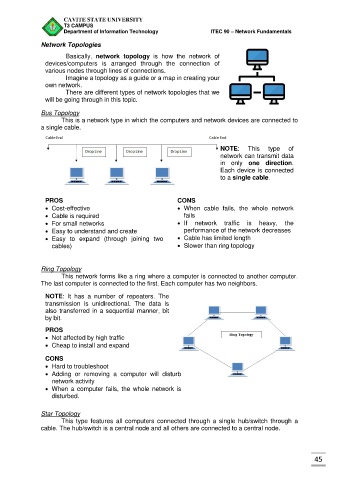Page 530 - PowerPoint Presentation
P. 530
CAVITE STATE UNIVERSITY
T3 CAMPUS
Department of Information Technology ITEC 90 – Network Fundamentals
Network Topologies
Basically, network topology is how the network of
devices/computers is arranged through the connection of
various nodes through lines of connections.
Imagine a topology as a guide or a map in creating your
own network.
There are different types of network topologies that we
will be going through in this topic.
Bus Topology
This is a network type in which the computers and network devices are connected to
a single cable.
NOTE: This type of
network can transmit data
in only one direction.
Each device is connected
to a single cable.
PROS CONS
Cost-effective When cable fails, the whole network
Cable is required fails
For small networks If network traffic is heavy, the
Easy to understand and create performance of the network decreases
Easy to expand (through joining two Cable has limited length
cables) Slower than ring topology
Ring Topology
This network forms like a ring where a computer is connected to another computer.
The last computer is connected to the first. Each computer has two neighbors.
NOTE: It has a number of repeaters. The
transmission is unidirectional. The data is
also transferred in a sequential manner, bit
by bit.
PROS
Not affected by high traffic
Cheap to install and expand
CONS
Hard to troubleshoot
Adding or removing a computer will disturb
network activity
When a computer fails, the whole network is
disturbed.
Star Topology
This type features all computers connected through a single hub/switch through a
cable. The hub/switch is a central node and all others are connected to a central node.
45

